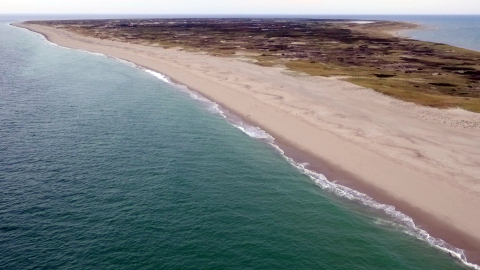Visit Us
National wildlife refuges offer us all a chance to unplug from the stresses of daily life and reconnect with our natural surroundings. Monomoy National Wildlife Refuge, is on the south east corner of Cape Cod in Chatham, Massachusetts. The visitor center located on Wikis Way is closed, however our information kiosk located near our flagpole at the end of Wikis Way is typically staffed from 10:00 AM to 4:00 PM everyday from Memorial Day to Labor Day to help you learn about the Refuge, tell you how to get to the Morris Island Trails, and to answer other general questions.
Pets are never allowed on South Monomoy, North Monomoy, and Minimoy islands. On Morris Island, which is where the refuge's headquarters are located, dogs are NOT permitted in the summer, from May 1st to September 15th, to protect the nesting wildlife. Leashed dogs are allowed on the Morris Island trails in the off-season, which is from September 16th to April 30th.
You can download a copy of our public access map here: https://www.fws.gov/media/monomoy-national-wildlife-refuge-public-access-map-2023
Location and Contact Information
About Us
Sand, dunes, and marshes stretch for eight miles off the elbow of Cape Cod, forming the barrier islands of North and South Monomoy, along with numerous islets and shoals. The Refuge consists of varied habitats of oceans, salt and freshwater marshes, dunes, and freshwater ponds. Nearly half of Monomoy's 7,921 acres is designated as Wilderness. The Wilderness designation recognizes areas where the earth is undeveloped, its community of life are untrammeled, and humans are visitors which leave no trace that they had been there so that the next visitor may have the same experience as the first.
Tours
Upcoming Events
August 12, 11:00 Am - 1:00 PM - https://www.fws.gov/event/migratory-bird-watching
What We Do
Wildlife conservation is at the heart of the National Wildlife Refuge System. It drives everything on U.S. Fish and Wildlife Service lands and waters managed within the Refuge System, from the purposes for which a national wildlife refuge national wildlife refuge
A national wildlife refuge is typically a contiguous area of land and water managed by the U.S. Fish and Wildlife Service for the conservation and, where appropriate, restoration of fish, wildlife and plant resources and their habitats for the benefit of present and future generations of Americans.
Learn more about national wildlife refuge is established to the recreational activities offered to the resource management tools used. Using conservation best practices, the Refuge System manages Service lands and waters to help ensure the survival of native wildlife species.
Monomoy staff, volunteers, and partners use an array of management tools to ensure the conservation of species and habitats and to keep visitors educated, protected, and most importantly appreciating nature. Some examples of this work include:
Conducting annual counts and nest monitoring of common, least, and roseate terns, as well as piping plovers, American oystercatchers, wading birds, and gulls.
Tagging horseshoe crabs to assess relative abundance and movements.
Gray seal research to better understand seal ecology, population structure structure
Something temporarily or permanently constructed, built, or placed; and constructed of natural or manufactured parts including, but not limited to, a building, shed, cabin, porch, bridge, walkway, stair steps, sign, landing, platform, dock, rack, fence, telecommunication device, antennae, fish cleaning table, satellite dish/mount, or well head.
Learn more about structure , movement rates, and diet.
Successful reintroduction of Northeastern Beach Tiger Beetle on South Monomoy Island, from which larvae are now collected to help repopulate other beaches.
Our Species
The Refuge's vast system of ocean, intertidal flats, salt and freshwater marshes, dunes and freshwater ponds, provide vital habitat for a vast array of diverse species.
The refuge provides important resting, nesting and feeding habitat for migratory birds, including the federally protected piping plover, roseate tern, and red knot. At least 25 species of seabird, shorebird, waterfowl, and colonial waterbird nest on three offshore islands. The refuge also supports the largest nesting colony of common terns on the Atlantic seaboard, exceeding 17,000 pairs in 2022.
In addition to many bird species this refuge supports grey seals, horseshoe crabs, seabeach amaranth, northeastern tiger beetles, and many more.
Get Involved
Volunteering, Internships, & Friends
We love our volunteers! Without their generous help, much of what we do at Monomoy, both in the Visitor Center and in the field, would not be possible.
The refuge typically has a variety of internship opportunities each summer ranging from biology and invasive species invasive species
An invasive species is any plant or animal that has spread or been introduced into a new area where they are, or could, cause harm to the environment, economy, or human, animal, or plant health. Their unwelcome presence can destroy ecosystems and cost millions of dollars.
Learn more about invasive species work to interpretation and education.
The Friends of Monomoy is the official Monomoy NWR friends group, who are devoted to the continued protection and management of the refuge
Projects and Research
For 2024 we will be highlighting our efforts to minimize shorebird disturbance as these birds have seen a continued decline in shorebird populations. The goal is to reduce the disturbance of migratory shorebirds on refuge owned or managed beaches. This will be accomplished by increasing the presence of trained personnel (staff, interns, or volunteers) on refuge beaches, improve communications about the issue, and observe positive or negative impacts to shorebirds to inform management decisions.
